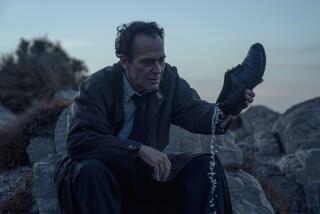Silent films and their soaring music are rediscovered
If you were part of the sold-out crowd at Walt Disney Concert Hall a week ago watching a screening of Carl Theodor Dreyer’s extraordinary 1928 “The Passion of Joan of Arc,” calling it a silent film would have made no sense at all.
For accompanying the film was a rapturous, overwhelming performance by the Los Angeles Master Chorale (115 members, plus five hard-working soloists and orchestra) of Richard Einhorn’s inspired “Voices of Light” oratorio, written to accompany the Dreyer film not as a traditional score but rather as both counterpoint and commentary.
Since its debut in 1994, Einhorn’s music has been performed more than 250 times, but, the composer cautioned in a pre-performance talk, it would be a mistake to see his exceptional music as some kind of way-new phenomenon: “a large screen, a large musical ensemble, this is the way people back then wanted to see silent film.” Judging by the tumultuous reaction of the Disney Hall audience, many of whom had no previous knowledge of the Dreyer film, today’s viewers feel the same way.
Mocked, ignored, the victim of a massive cultural disinformation campaign that insisted these movies were too primitive to take seriously, silent film has managed to outwit history. Not only is there a phoenix-like rebirth of interest in the medium, but the films themselves and the artifacts surrounding them are constantly coming to light in rich and unexpected ways.
Just in the past month, two major new discoveries have been announced of films that were either considered lost forever or were totally unknown to silent film historians.
Considered gone, gone, gone since its debut in 1916 was the silent version of “Sherlock Holmes” starring William Gillette, discovered at the Cinematheque Francaise and due to have its American debut at the San Francisco Silent Film Festival in May of next year.
Gillette was the great stage actor who had years earlier created many of the physical attributes that found their way into the pipe-smoking, deerstalker cap-wearing Holmes of the popular imagination. He was so good that the author Booth Tarkington once wrote him, “I would rather see you play Sherlock Holmes than be a child again on Christmas morning.”
Only a few days before that, New York’s Museum of Modern Art announced it had found in its archives an unreleased and unknown 1913 film starring Bert Williams (according to W.C. Fields “the funniest man I ever saw and the saddest man I ever knew”) that may be the earliest surviving film with a black cast.
The “Joan of Arc” print shown Oct. 19 has a discovery story all its own. The film’s original negative was destroyed in a fire at the UFA studio in Berlin not long after its 1928 debut, and those who saw the film in the 1950s, ‘60s or ‘70s saw what one critic called “mangled and mixed versions.” Then, incredibly, a print of the original version came to light, so to speak, in 1981 in the janitor’s closet of an Oslo mental institution.
Films like those remain undiscovered in archives because cans can be mislabeled and ever-shrinking budgets means lack of projection room time to screen what’s in them and determine exactly what it is.
It’s not only films that are being rediscovered, it’s artifacts as well. Last week’s screening of “Joan” inspired a woman in Brentwood to look in her closet and come forward with stunning stills from the Dreyer film she had inherited, stills so rare that the Academy of Motion Picture Arts & Sciences, repository of some 10 million photographs, said it had never seen most of them.
And 10 days ago, the executive director of the Guadalupe-Nipomo Dunes Center in California announced that an enormous plaster sphinx used during the filming of Cecil B. DeMille’s 1923 “The Ten Commandments” had been uncovered beneath the sands.
Also new in the silent film world is the great number of movies available for home viewing. The Warner Archives Collection has numerous silents on its list, and Oldies.com, a premier source of vintage films, has for the first time put out a 40-page catalog devoted exclusively to silent films, where hundreds of items (including such oddities as 1927’s “Fangs of Destiny,” starring Dynamite the Dog) can be purchased.
To be seen to their best advantage, however, silent films should be experienced, as they were in the medium’s glory days, with live musical accompaniment, something last week’s “Joan” screening convincingly demonstrated.
It’s not that Dreyer’s film isn’t worthy of notice all by itself. Directed with rigor and vigor, featuring Rudolph Mate’s austere but vibrant cinematography, it has become an enduring classic because of Renee Falconetti’s once-in-a-lifetime performance as the Maid of Orleans, part village girl, part saint, a young woman whose luminous face, shot in enormous close-up from a variety of angles, was both timid and transcendent.
Still, to understand what makes silent film so special, the central place of music can’t be avoided. As the late film authority William Everson explained several years ago, “The score minimized flaws, added punctuation and feeling, stretched the emotionalism and guided the audience into the right frame of mind. It’s a major crime, absolutely deadly, to show these films without the proper accompaniment.”
This was especially the case with Einhorn’s music and “Joan of Arc.” From the moment those Master Choral voices rang out, the enormous emotional connection the combination of sound and image created was transporting. The live music enhances what we see, bringing us inside the film, inside Joan’s experience, enabling us to in a sense go on her spiritual journey with her.
While “Joan of Arc” was a one-time event, Los Angeles has numerous opportunities to see silent films with live music, including one-shots like a recent screening of Alfred Hitchcock’s “The Lodger” from 1927 at the Crest in Westwood and the Cinefamily’s monthly “Silent Treatment” series. To enter this world is to understand why Mary Pickford, one of its biggest stars, famously said that “it would have been more logical if silent pictures had grown out of the talking instead of the other way around.”
Twitter: @KennethTuran
---------------------------------
‘Voices of Light’
What: Los Angeles Master Chorale performs Richard Einhorn’s 1994 score accompanied by a screening of “The Passion of Joan of Arc”
When: “Listen Up!” pre-concert talk at 6 p.m., concert at 7 p.m. Sunday
Where: Walt Disney Concert Hall, 111 S. Grand Ave., L.A.
Tickets: $24 to $74
Info: (213) 972-7282, https://www.lamc.org
More to Read
Only good movies
Get the Indie Focus newsletter, Mark Olsen's weekly guide to the world of cinema.
You may occasionally receive promotional content from the Los Angeles Times.











